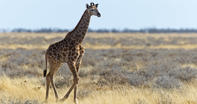
Name
Giraffe (giraffa camelopardalis)
Order - Artiodactyla Family - Giraffidae Giraffes’ species name camelopardalis means camel-like leopard.
The leopard (pardalis) refers to its colouration while the camel-like similarity exists in the way giraffe walk, moving the two legs on the left side, followed by the two legs on the right side. This pattern of walking helps to prevent the long legs tangling with each other and the neck assists with balance.
When giraffe gallop, the front and back legs operate like those of a hare. The hind pair exceed where the front pair have just landed between them. Giraffe can reach 50-60 kmph when galloping. By Megan Emmett
Appearance
The giraffe is the tallest land animal in the world. Males can reach a height of 5 m, and females 4.5 m. Their extremely long necks are partly what makes them this tall, causing an intricate blood circulatory system which is still not fully understood by zoologists. Large giraffe males can weigh as much as 1200 kg, whereas females have a mass of 800 to 900 kg.
Both sexes have short, skin-covered horns, and are yellowish-brown in colour. Males have dark brown patches, and females light brown. Giraffes have a running speed of 55 km/h.
Giraffe Diet
Giraffes can eat the foliage from trees out of reach of other herbivores because of their very long necks. Using their long prehensile tongues, they pull leaves and pods into their mouths and strip the food from its stem with their broad, rounded incisors.Giraffe Breeding
After a gestation period of 13 to 15 months, a single calf is born, weighing about 100 kg. They are weaned between 6 to 8 months of age, yet only about 52 percent of giraffe calves reach maturity, because lions, leopards, and hyenas hunt them as prey. A calf reaches sexual maturity between 4 or 5 years of age. Adult bulls move from group to group to check whether there are cows receptive to reproduction.Giraffe Behaviour
Being rather social animals, giraffes at times gather in herds but do not bond as groups. Adult females are accompanied by a few youngsters, whereas males are nomadic and move between female groups in search of one who may be receptive to reproduction.
Giraffes have no specific breeding period, therefore males continuously wander between female groups. Male giraffes fight for dominance and to mate with females. This is an interesting tussle to watch and rarely leads to injury. Using their long, strong necks, they hit one another’s bodies and interlace their necks. The winner pushes the other off balance.
Giraffes are rather quiet and calm animals, and only snort when disturbed or bellow when attacked by predators.
Where are Giraffes found
Hunting, farming, and disease such as rinderpest have fractured the historical distribution of giraffes. Due to conservation efforts and a reintroduction to game reserves and private farms, conserved giraffe populations are flourishing in South Africa.Spoor Description
Giraffes leave a distinctive square-toed print and are vulnerable to breaking limbs by slipping on wet surfaces.Field Notes
In Africa, there are nine subspecies of giraffe. Some scientists believe a few giraffes should be classified as separate species.
The subspecies are:
Giraffa camelopardalis camelopardalis - Nubian giraffe of Sudan and Ethiopia
Giraffa camelopardalis reticulata - Somali or reticulated giraffe found in Kenya, Somalia and southern Ethiopia
Giraffa camelopardalis angolensis - Angolan or Namibian giraffe which can be found in northern Namibia, southwestern Zambia, western Zimbabwe and Botswana
Giraffa camelopardalis antiquorum - Kordofan giraffe which can be found in southern Chad, Central African Republic, Democratic Republic of Congo and Cameroon
Giraffa camelopardalis tippelskirchi - Masai or Kilimanjaro giraffe of Tanzania and Kenya
Giraffa camelopardalis rothschildi - Rothschild, Baringo or Ugandan giraffe of Uganda and Kenya
Giraffa camelopardalis - South African giraffe found in South Africa, southern Zimbabwe and southern Botswana, and Mozambique
Giraffa camelopardalis thornicrofti - Thornicroft or Rhodesian giraffe, which can only be found in the Luangwa Valley in Zambia
Giraffa camelopardalis peralta - the West African or Nigerian giraffe
 Did you know? Giraffe are believed to be the mammal pollinator of the knob thorn tree Acacia nigrescens....
Did you know? Giraffe are believed to be the mammal pollinator of the knob thorn tree Acacia nigrescens.... The giraffe is the world’s tallest land mammal and has some curious adaptations to accommodate its lifestyle....
The giraffe is the world’s tallest land mammal and has some curious adaptations to accommodate its lifestyle.... Giraffes’ long necks give them a height advantage and they can access a two-metre band of vegetation out of reach to all other herbivores ...
Giraffes’ long necks give them a height advantage and they can access a two-metre band of vegetation out of reach to all other herbivores ... Giraffe are gregarious and still prefer to be around members of their own kind even though the makeup of the group fluctuates...
Giraffe are gregarious and still prefer to be around members of their own kind even though the makeup of the group fluctuates...